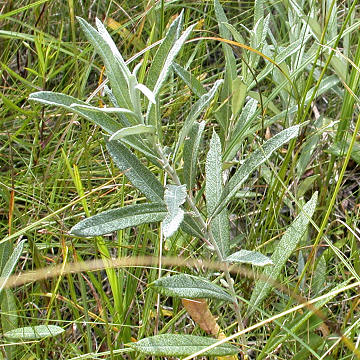

Salix humilis - (image 1 of 5)
Taxonomy
Family: Salicaceae
Habitat
Open woods, sandy areas, barrens, and mesic and wet prairies. Fire adapted
Associates
Distribution
Newfoundland and Quebec, west to ND, south FL to TX.
Morphology
Deciduous shrub 1-3 m tall. Twigs yellow to brown, supple, velvety or eventually glabrate but not glaucous. Leaves dark (gray?) green and often minutely pubescent above, glaucous and more or less gray-tomentose below, alternate, oblanceolate to obovate, acute to short-acuminate; margin somewhat revolute and entire or remotely undulate-crenate; stipules lanceolate and often deciduous; petioles 3-7 mm. Catkins sessile or subsessile, forming before the leaves; scales blackish, 1.5-2 mm; staminate catkins 1-2 cm, with 2 stamens; pistillate catkins 1.5-4 cm. Fruits 6-10 mm, on pedicels 1-3 mm, gray-hairy; style less than 1 mm.
Notes
Flowers early April to early May
Wetland indicator: Facultative Upland
A highly variable species. The plants pictured here may fit var. microphylla (Anderson) Fern., which has quite narrow leaves that are pubescent above and petioles less than 3 mm long. Gleason & Cronquist would call this S. occidentalis Walter.
References
Gleason, Henry A. and A. Cronquist. 1991. Manual of Vascular Plants of Northeastern United States and Adjacent Canada. Second Ed.
The New York Botanical Garden. Bronx, NY
Swink, F. and G. Wilhelm. 1994. Plants of the Chicago Region.
Indiana Academy of Science. The Morton Arboretum. Lisle, Illinois.
|
Michael Hough © 2005 |